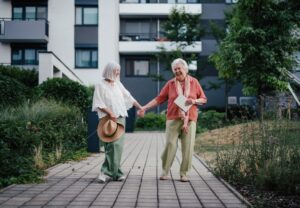For individuals transitioning from a nursing facility to community living, home accessibility is paramount. The New York State Nursing Home Transition and Diversion (NHTD) Waiver Program provides crucial support to make this transition successful. A key part of this support involves funding for physical changes to a person’s home. The environmental modifications covered by NHTD are designed to remove physical barriers, enhance safety, and promote independence. These vital environmental modifications can transform a challenging living space into a safe and accessible home, empowering participants to live with greater freedom and confidence. Reach out today to learn more about how we can help you enhance your golden years.
What Are Environmental Modifications Covered by NHTD?
Environmental Modifications, often referred to as “E-mods,” are internal and external physical adaptations to a home that are necessary to ensure the health, welfare, and safety of individuals in the NHTD Waiver Program. These changes are specifically designed to address a participant’s functional limitations, enabling them to live more independently in the community and avoid institutionalization. The goal is to create an environment where individuals can carry out their daily activities with greater ease and reduced risk. These modifications are a critical component of the comprehensive NHTD waiver services available to eligible participants.
Key Types of Covered Modifications
The NHTD program can cover a wide range of modifications, provided they are directly related to the participant’s disability-related needs. These are assessed on a case-by-case basis and must be included in the participant’s service plan.
1. Ramps and Lifts for Accessibility
One of the most common challenges is navigating entrances and different levels of a home. E-mods directly address this.
- Wheelchair Ramps: Installation of permanent or portable ramps to provide a safe and accessible way to enter and exit the home for wheelchair users.
- Stair Lifts and Vertical Lifts: Installation of mechanical lifts to help individuals safely move between floors when they are unable to use stairs. This can be a transformative modification for accessing bedrooms or main living areas.
2. Bathroom Modifications for Safety
The bathroom is a high-risk area for falls. NHTD-covered modifications can make it one of the safest rooms in the house.
- Roll-in Showers: Creating a barrier-free shower that allows a wheelchair to roll directly in, eliminating the need to step over a tub ledge.
- Grab Bars and Handrails: Installation of sturdy grab bars in the shower, tub, and near the toilet to provide support and prevent falls.
- Raised Toilets: Installing a toilet at a more accessible height or adding a raised seat to make sitting and standing easier.
- Widened Doorways: Expanding the width of the bathroom doorway to accommodate a wheelchair or walker.
3. Kitchen Accessibility
Making the kitchen usable allows participants to prepare their own meals, a major step toward independence.
- Lowered Countertops and Sinks: Modifying kitchen surfaces to a height that is accessible from a seated position.
- Accessible Cabinets: Installing pull-down shelving or creating open shelving to make items easier to reach.
- Lever-style Faucets: Replacing standard faucet knobs with lever handles that are easier to operate for individuals with limited hand strength.
4. General Home Safety and Access
Other environmental modifications focus on improving overall safety and movement throughout the home.
- Widening Hallways and Doorways: Similar to the bathroom, widening other key doorways and hallways in the home to ensure easy passage for mobility devices.
- Installation of Specialized Flooring: Replacing carpeting with smooth, non-slip surfaces that are easier for a wheelchair to move across.
- Automated Door Openers: Installing systems that open doors automatically, providing greater independence for individuals with limited strength or mobility.
How to Access Environmental Modifications Through NHTD
Accessing these modifications requires a structured process within the NHTD Waiver Program.
- Assessment: The participant’s need for specific E-mods is identified by the service coordinator and other professionals during the development of the service plan.
- Justification: The requested modification must be directly linked to the individual’s documented medical needs and functional limitations.
- Bidding Process: The Service Coordinator will typically obtain bids from approved contractors to perform the work.
- Approval and Installation: Once approved, the modifications are completed by the chosen contractor.
The service coordinator is the participant’s primary guide and advocate throughout this process, ensuring all requirements of the NHTD waiver services are met.
The environmental modifications covered by NHTD are more than just construction projects; they are life-changing adaptations that provide freedom, safety, and dignity. By funding essential changes like ramps, lifts, and accessible bathrooms, the program breaks down physical barriers that would otherwise prevent individuals from living in the community. These modifications are a powerful example of how the NHTD program invests in the long-term independence and well-being of its participants, allowing them to truly feel at home in their own homes. Feel free to call HouseCalls Home Care at 718-922-9200 if you or a loved one requires compassionate and competent in-home care services. You can also send an email to us at info@HouseCallshc.org for more information. Our goal is to help you find the best support for your needs. Alternatively, you can register your information at https://yuz88hfiyh7.typeform.com/to/E5thuv5G?typeform-source=statics.teams.cdn.office.net, and we will get back to you.




